I took delivery of a Tesla Model S (S85 model) a week ago today and after 700kms here are a few thoughts on the car that are not so often covered in reviews.
- All things considered this is a fantastic car and a) I’d buy it again knowing what I know now and b) I honestly believe this is the future the future of motoring (at least until self driving cars take over).

- The Tesla Model S will (in my view) without doubt will do to the car industry what the iPhone did in 2007 to the mobile phone industry. Give it time and every car manufacturer will be making something that resembles it, only vehicle development being slower than smart phones it will take a little longer. Will Tesla dominate the industry as a new player as Apple did or will the established incumbents relegate them to a niche player through volume. Either way I think they’ve already caused the change that will come. Along the way I’ll be surprised if we don’t see some laggards go out of business through their failure to change copy it.
- For the spirited drivers – this is not a sports car.
- Performance: Much of the hype about the Model S is focussed on it’s standout performance (compared to other electric cards). In reality this performance is good for a few sprints off the traffic lights but if you consistently drive the car at or near full throttle for 5-10 minutes the power is cut back by around 40%. An orange dashed line appears at the point of limitation on the power gauge (nearest thing to a tachometer in a traditional car) and the car is limited to this.
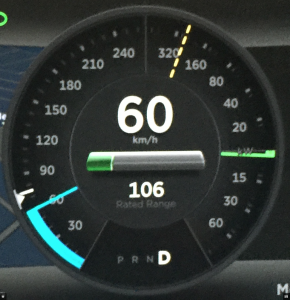
- I understand this limit is related to heat generation in the battery pack from the high current draw. If the car is driven gently after 10 minutes or so it cools down and the power limit is removed until you overheat it again.
- This power reduction has a significant effect on performance.
- Teslarati note that the power limits will kick in after a single lap on a track day and recommend only doing half sessions.
- Handling: not forgetting that this is a 2.1 tonne car it handles remarkably well. It feels solid and poised on the road. ABS, traction and stability control all intervene in a smooth and measured fashion that doesn’t unsettle the car or overly distract the driving. The traction control to me feels more digital or clinical than is possible in a petrol car perhaps due to the speed at which power delivery can be altered.
- Being silly:
- You can disable traction control but not stability control (without pulling fuses that also take out other important functions like power steering).
- With traction control off the car won’t break traction from a standing start in a straight line on dry roads. Put it into a corner and “gas it up” and you can kick the rear wheels out a little but it doesn’t take long for the stability control to limit the power, activate the brakes and bring the car back into line.
- Electric motors produce their maximum torque at zero revs. Power delivery is very rapid and instantaneous compared to petrol cars. No waiting for the revs to reach the point of maximum power output, no getting caught in the wrong gear or waiting for the automatic transmission to change to the right gear. Zipping around is fun in this car.
- Prior to owning the car a few times I wondered why we’d not seen a review on Top Gear. Given the above I fully expect they would pan it if / when it ever does make it on to the show. This is not a sports car.
- Performance: Much of the hype about the Model S is focussed on it’s standout performance (compared to other electric cards). In reality this performance is good for a few sprints off the traffic lights but if you consistently drive the car at or near full throttle for 5-10 minutes the power is cut back by around 40%. An orange dashed line appears at the point of limitation on the power gauge (nearest thing to a tachometer in a traditional car) and the car is limited to this.
- Real world battery range
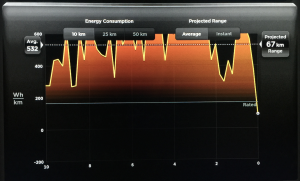
- The rated range (think maximum achievable) of the car is 500km and the car prominently reports this figure to you akin to a fuel gauge whilst driving. Achieving this range means driving in an optimally efficient manner. I’ve not yet been able to achieve this over any length of time (the rapid acceleration is still a novelty) but I’m quite certain it means driving with the traffic, no hard acceleration and limited use of air-conditioning.
- The equivalent measure of fuel efficiency (Litres/100km) is Watt hours / kilometre (Wh/Km). The battery contains 85,000 Wh or 85 kWh so Wh / km is simply a function of how many of these you use per kilometre driven. To put some meaning into this number, the average Australian home uses around 20kWh per day, so this is the equivalent of 4 days worth of energy consumption.
- Getting 500 km out of a full charge means driving at 170 Wh/km. In my first week I’ve averaged 330 Wh/km, or half the rated range. Spirited driving will push this number over 600 Wh/km or 1/4 of the maximum range, you could only consistently hit this on a race track over a full battery so real world will always be something closer to a 250km minimum.
- Smooth driving – whilst the car is more noted for its performance, to me more joy comes from driving it around town in a very smooth manner. This is when it’s most different to other cars.
- It’s not silent – you hear tyre and wind noise that is present in all cars but normally masked by the engine noise – but it’s much much quieter. It’s eerily quiet at low speeds and on smooth roads.
- The accelerator pedal works differently. This car doesn’t coast. Pushing down gives you power, letting off activates regenerative braking through the electric motor. Maintaining a constant speed means holding the accelerator at the mid-point between the two. The regenerative breaking will slow you down to 10km/hr, astute use of it and judgement of stoping distances in traffic mean you can avoid using your brake pads for all but the last moment.
- Email support. It feels very foreign but you can email Tesla for help with this car and get prompt and useful answers. Since it comes with its own 3G Internet connection they can even push changes or get information about your individual car.
- Mobile phone app: the screen shots are self explanatory.
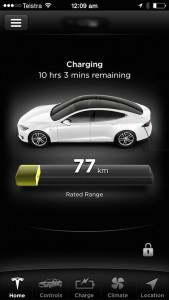
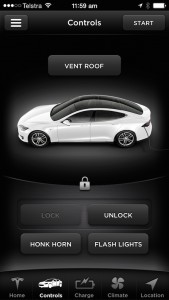
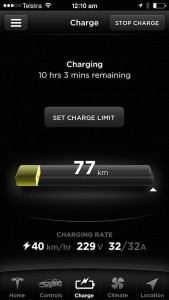
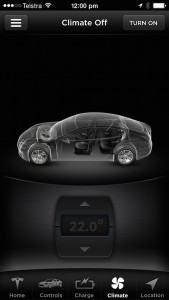
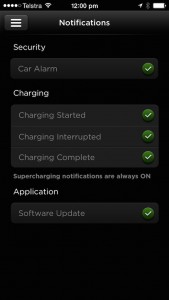
My feature wish list
Things I feel are missing or would love to see because the technology in the car makes it possible:
- The car automatically reads speed signs with a relatively high degree of accuracy (school zones and signs on adjacent motorway off ramps excepted). I’d love for a throttle position circa half way to only take me up to the speed limit with the ability to override with a more assertive push.
The right hand side of the instrument cluster (behind the wheel) is under utilised, it’s mostly empty.- Holding down the scroll wheel on the right hand side of the steering wheel lets you add content to the right side and similarly make changes on the left.
- The web browser has been disabled in Australia, please turn it back on, even if it’s only accessible when stationary.
- Drift mode. A traction and stability control setting that allows you to create intentional amounts of oversteer / understeer without violent cut offs. BMW and Ducati can do this on their motorbikes, surely Tesla can in a car!
- The parking sensors are often a little overzealous, especially in the garage. I regularly get a “stop” warning when I’m still 50cm away from an object. A little more granularity here would be nice.
- A forward facing wide angle camera. This would help with the parking and the stop warnings above to pickup gutters and low objects obscured by the bonnet.
- An augmented reality style parking lines overlay on the reversing camera. Not an uncommon feature on other cars.
- A Tesla supported / factory optioned tow bar. Torklift Central make an aftermarket hitch (see also the Teslarati review) but I’m unclear on their effect on warranty. You would also need to have a warning harness in stalled for lights.
- A power conservation mode to get you to your destination. Integrating with the nav system it should be possible to limit the acceleration and speed to help you get to your destination if possible when you’re low on charge. This could even help choose the most energy efficient route – factoring in gradients and traffic. This could be a material help with range anxiety.
- An option to have the regenerative braking bring you to a complete stop.
- The sleek lines of the car create their share of vision limitations. A sensor to tell you when there are cars in your blindspot could help here. Again other manufacturers have this already.
Tesla Related Websites
- Tesla Motors Club – Tesla Forum
- Teslarati – Tesla Forum
- EVnomics – Australia based vendor of Tesla accessories
- EV Trip Planner










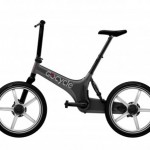
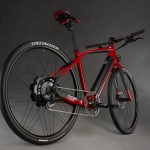
Respond to Australian Tesla Model S Review